Getting a new provider enrolled in health insurance networks can feel like a daunting and tedious task. First, you need to collect a ton of information on their credentials, work history, and qualifications. Then, you must organize that data, effectively credential the provider, and submit it to the payer before they allow you to bill for the new provider’s services.
The problem? There’s a good chance you’ll need to repeat this process for multiple insurance networks—and it gets even more complicated if the new provider has gaps in their work history or has recently changed jobs. This is just one small part of the more prominent provider credentialing process that—much like a snowball—only gets bigger as it rolls along. In this guide, we’ll explain how to credential a provider to help your organization tackle this task and improve the efficiency of your operations.
Provider credentialing services from Azulity can help your organization improve its approach to credentialing healthcare providers. Our innovative data management system allows healthcare organizations to streamline provider enrollment processes, making them faster and less painful.
Importance of Provider Credentialing In Healthcare


Credentialing Builds Trust Between Providers and Patients
Credentialing verifies the qualifications of healthcare professionals so patients can feel confident in their chosen providers. When patients seek treatment, they often look past the facility they’re visiting and focus on the medical professionals responsible for their care. Seeing that the doctors and practitioners in their chosen facility have the proper qualifications and certifications is crucial to alleviating patient concerns.
Credentialing Helps Prevent Revenue Loss
Credentialing helps medical practices avoid losing out on significant revenue. Without proper credentialing, facilities may experience considerable delays in reimbursements if they receive any payment. This is because insurance providers require that medical professionals and facilities are appropriately credentialed before issuing any fees for a patient’s care. If a medical practice fails to do this, it might not get paid for a patient’s care, especially if that patient goes to another facility for follow-up care.
Credentialing Reduces the Risk of Medical Errors
Medical errors are responsible for approximately 98,000 deaths in the United States each year. This shocking number has spurred industry leaders to call for better standards of exposure and competency, as well as disciplinary measures against healthcare professionals. Credentialing for healthcare facilities and independent practitioners helps lower medical error risk.
Credentialing Protects Against Lawsuits
Having an accurate and complete record of every practitioner’s credentials will be helpful in litigation. For example, you can save yourself if there is a negligence claim against a healthcare professional in your institution. In short, you can save your facility from a lawsuit by confirming that you verified all of their credentials as required.
Credentialing with Insurance Networks
The process takes patience and time. First, you have to decide to proceed. Second, you must shortlist the insurance companies you want to work with. Finally, it’s time to take the first step. Understanding that the credentialing procedure may take a few months is crucial.
Related Reading
- CVO Credentialing
- Best Credentialing Software
- Credentialing in Healthcare
- How Long Does Credentialing Take
How to Credential a Provider In 9 Simple Steps


1. Streamlining the Process with Azulity
Credentialing a provider has much in common with the onboarding process for a new employee. It requires the collection and verification of numerous documents, and it can be tedious. Both methods have a lot of paperwork that can vary based on the specialty of the new hire. Also, there are often delays if there are any discrepancies in the information. The good news is that medical credentialing and onboarding are becoming less painful, thanks to technology.
Credentialing solutions help organize, automate, and streamline the process to save time and reduce errors. For example, the right software can help by creating a centralized database for all documents and verifying information with external sources. Azulity specializes in healthcare master data management and provider credentialing services, bringing proven expertise in implementing healthcare data solutions and credentialing across the US.
Our comprehensive platform ensures consistent patient, provider, location, and claims data synchronization across all systems and departments. Key features include healthcare MDM, provider MDM, reference data management, credentialing, and provider enrollment. We serve healthcare technology leaders – from CIOs and CDOs to VPs of data platforms and credentialing – helping them eliminate the costly problems of fragmented data systems. Book a call to learn more about our healthcare master data management services today!
2. Getting Ready for Credentialing
With so many documents, the credentialing process can often overwhelm healthcare providers. In short, the process has two steps:
Credentialing
The credentialing phase is when the insurance company checks all your credentials. It verifies if you meet their requirements for participating in their network.
Contracting
The contracting phase is where the company issues you a participating provider agreement. This document defines the terms of participation for receiving in-network reimbursement for your claims.
3. Focus on the Insurance Companies
You could be required to submit many applications during the credentialing process. It could be beneficial to focus on the dossiers you file first. For example, if you send many of your billing to a single insurance company, finish out their healthcare credentialing form first. Stay up to date about individual health insurance rules.
Some health insurers enable providers already insured in that other state to undergo a simplified process, which could result in faster approvals. Many insurance providers have shortened the application process for providers who have already been credentialed throughout.
For example, a dermatology practice in California saw that 75% of its patients were insured through Blue Cross Blue Shield (BCBS). The practice prioritized submitting the BCBS credentialing form first and coordinated with their support team for a faster review. Meanwhile, for a secondary insurer, Aetna, the provider leveraged an expedited process by proving prior credentialing in another state.
4. Verify Accurate Information
When you begin to compile the necessary papers and fill out individual applications, it’s crucial to ensure data accuracy & standards. Follow these procedures before filing any applications: Run a full background check. Check educational background, license, professional certification, & reputation with healthcare groups like- AMA, ECFMG & ABMS. Examine the credentials, advantages, & health insurance claims background. Once you’ve gathered and reviewed these papers, you can present them to facility administration, who will decide which particular privileges to give to the provider. This info is crucial for the credentialing process.
Other alternatives include:
Credentialing software
The ideal credentialing software saves data and can include features that make your credentialing procedure more straightforward and effective.
Outsourcing
Is your human resources department overburdened with medical credentialing services? Outsourcing or using a medical credentialing service may reduce time and money.
Example
A rural hospital in Texas was onboarding a surgeon. During credentialing, a clerical error caused a mismatch in the surgeon’s medical license number. Additionally, the surgeon’s name on the CAQH profile differed from their license record, so correcting this information was delayed a month.
5. Completing the Council for Affordable Quality Healthcare (CAQH)
Several large medical insurers mandate partner clinics register for CAQH accreditation (Simultaneously, they must register their applications). Once your clinic has submitted a form to a specific insurer, they will give you a Council for Affordable Quality Healthcare (CAQH) ID number and an invitation to register. Any correct info must be accurate to ensure CAQH clearance.
Be ready to re-attest after submitting your initial application. What is re-attestation? To hold ongoing insurance eligibility, one must verify whether a provider’s data is accurate 4 times yearly.
Example
A pediatric clinic in Ohio received a CAQH invitation after applying for credentialing with Humana. The clinic missed the first re-attestation reminder, temporarily stalling the approval process. After implementing calendar reminders and assigning a dedicated staff member to manage CAQH updates, they avoided future delays.
6. Collecting Information
A healthcare facility or health insurance plan asks the provider for information on his or her background, licenses, education, etc. The provider may submit the information in a questionnaire through email or software. Sometimes, the healthcare facility or insurance company works with a third-party company—called a credentials verification organization (CVO)—that works with the provider to gather and verify information. Organizations often hire CVOs to allow for more efficient credentialing.
7. Validating the Information
Often, the facility or insurance company will do the background work. They will directly correspond with licensing agencies, medical schools, and other entities to verify the provider’s information. In other cases, the facility or insurance company may use credentialing software to continuously check information that licensing agencies and other entities make available online. The CVO may also run verification checks.
Many healthcare organizations use collaboration and work management platforms to help them organize and record provider information and get automatic updates when specific credentials expire or need to be re-checked. In all cases, the checks include monitoring reports about medical incidents, malpractice claims, or other information that could raise questions about whether to credential or re-credential the provider.
8. Granting the Provider Credentials
After the organization verifies all required credentials and finds no negative issues, the healthcare facility awards credentials to the provider. After the health insurance company completes a similar process, it can approve the provider as an in-network provider. The insurance company will pay the provider to treat insurance patients.
9. Ongoing Tracking of Credentials
Don’t wait 5 or 6 months for an insurance provider to contact you. Credentialing medical specialists reveal the importance of continuous follow-ups for quick approval. Develop connections with central insurance business personnel.
Developing a good working relationship with management, executive associates, and other staff members could help guarantee that applications are processed quickly. Instead of following up through email to boost response chances, use the phone. If you notice that more info is necessary, compile and check all documentation as quickly as possible.
Example
A family medicine practice in Atlanta used Excel spreadsheets to track credentialing statuses but often missed follow-ups. After a consultant recommended using a credentialing management system (e.g., Modio Health), they automated reminders for follow-ups and document updates. This proactive approach halved their typical approval time with insurers.
7 Best Provider Credentialing Software for Healthcare
1. Azulity: Streamlining Healthcare Credentialing with a Robust Master Data Management Platform
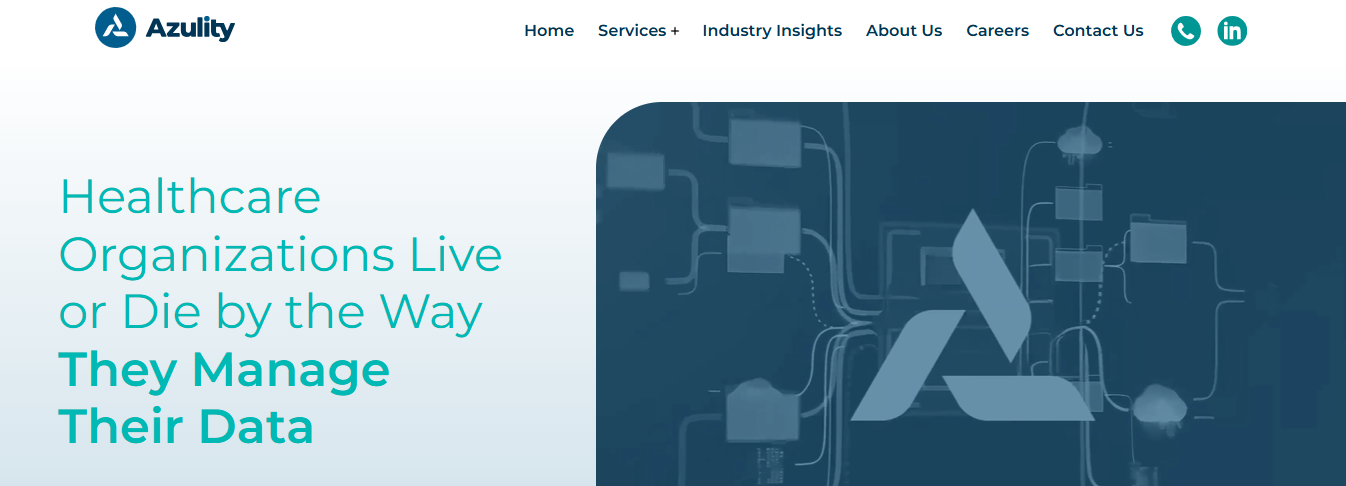

Azulity is a leader in healthcare master data management and provider credentialing services. With a comprehensive platform, Azulity consistently synchronizes patient, provider, location, and claims data across all systems and departments. Key features include healthcare MDM, provider MDM, reference data management, credentialing, and provider enrollment. Azulity serves healthcare technology leaders — from CIOs and CDOs to VPs of data platforms and credentialing — helping them eliminate the costly problems of fragmented data systems.
2. Credentialing Spectrum: One-Click Automation for Credentialing
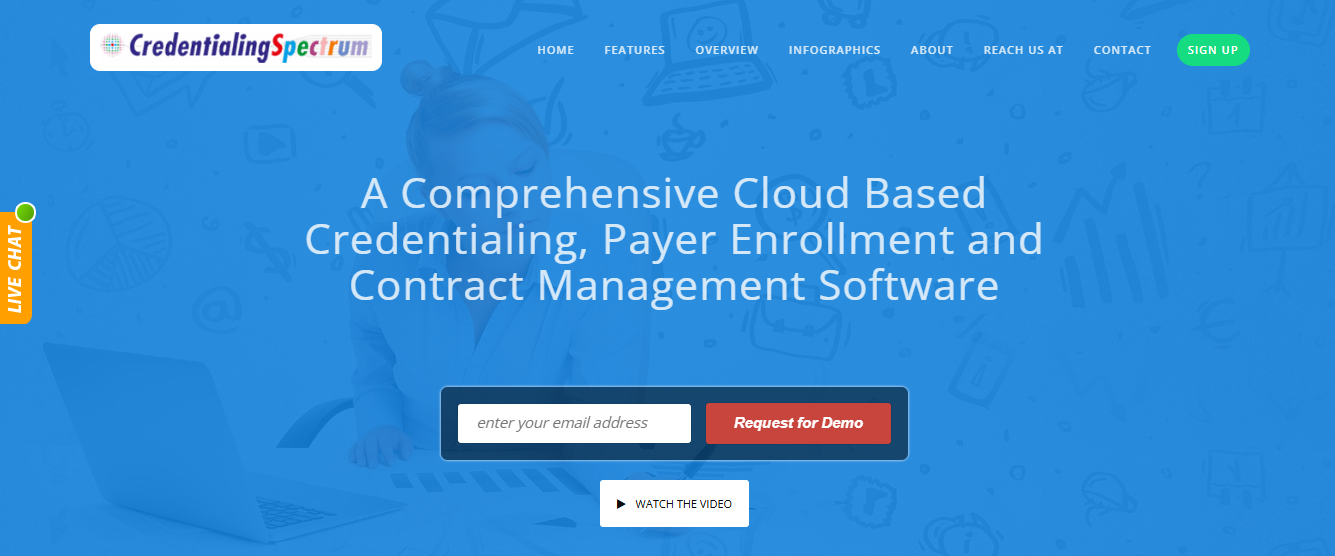

CredentialingSpectrum is secured, cloud-based medical credentialing software for facility, payer, and contract management. It simplifies the process and increases efficiency. CredentialingSpectrum is a one-click comprehensive automation system that makes it convenient.
Pros
- Automates tasks: CredentialingSpectrum can automate provider credentialing, enrollment, and privilege management.
- Saves time: CredentialingSpectrum can help save time for staff by automating tasks.
- Improves efficiency: CredentialingSpectrum can improve efficiency for healthcare organizations of all sizes.
Cons
- Credentialing is complex: The credentialing process can be complex and involve many variables.
- Credentialing can be lengthy: The credentialing process can be lengthy and labor-intensive, taking up to 90 days for an application review.
3. MedTrainer: Credentialing Software Built for Healthcare Compliance
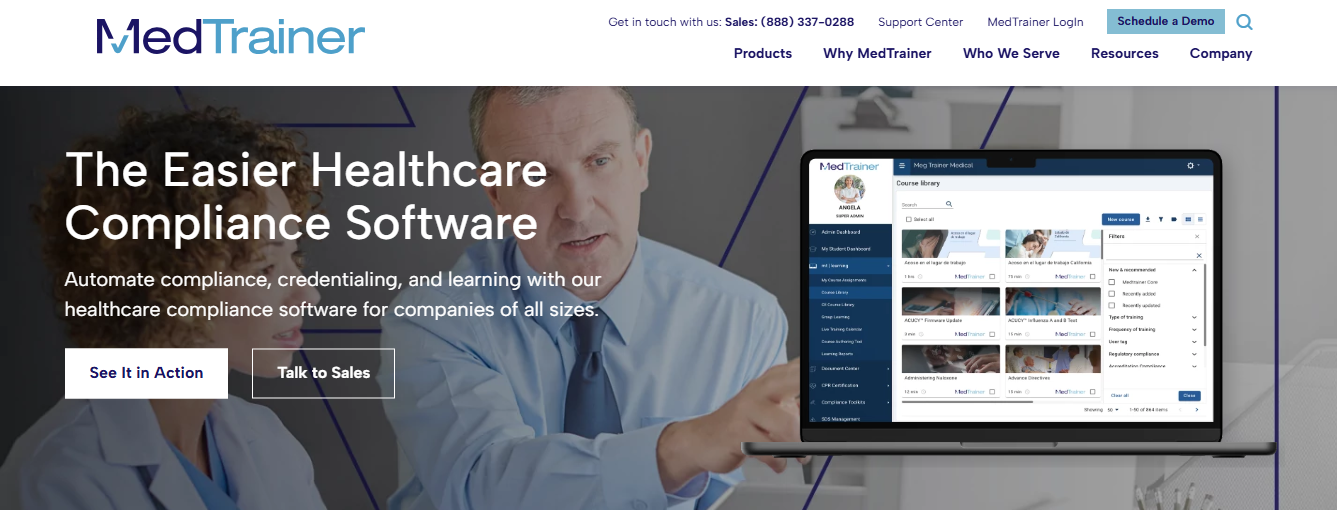

MedTrainer Credentialing is built for healthcare organizations that want to manage the credentialing process but need to complete more in less time. G2 reviewers agree, ranking MedTrainer as a High Performer for Healthcare Credentialing Software for the second straight quarter and notching the highest overall score for Quality of Support in the G2 Summer 2024 Report.
More than 3,000 organizations rely on MedTrainer to streamline compliance with a unified digital platform that optimizes workflows and accelerates education, credentialing, and documentation. As a leader in healthcare technology, MedTrainer constantly innovates to give customers the best experience and the most capabilities within one platform.
Pros
- Comprehensive solution for healthcare compliance training and credentialing
- Intuitive dashboard for real-time visibility and analytics
- Responsive customer support
- Up-to-date content library from expert partners
Cons
- Some users mentioned the learning curve to be slightly steep
- It may require customizations to meet unique organizational needs fully
4. Symplr Provider Credentialing: Automate the Data-Driven Credentialing Process
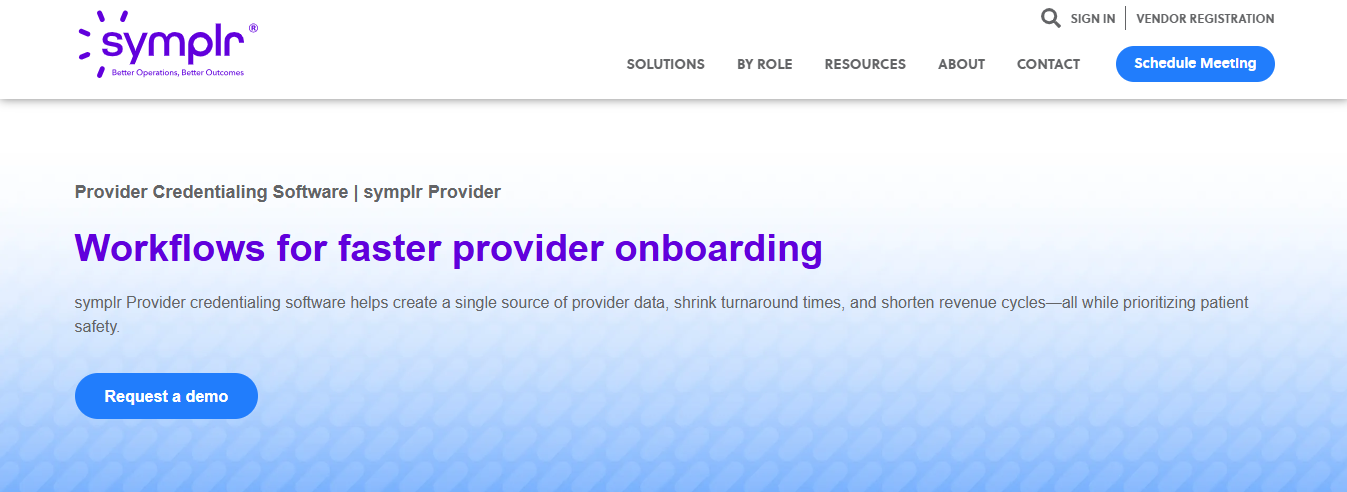

symplr’s provider credentialing software creates a single source for data on providers, reduces turnaround times, and shortens the revenue cycle, all while prioritizing the safety of patients. Symplr’s Provider Credentialing Software makes data collection, secure access, report generation, and ongoing compliance easier for providers, credentialing personnel, and internal approval panels.
Their customers report a reduction of 20% in credentialing timelines and a 50% reduction in committee meetings. In one automated, user-friendly hub, you can collect, verify, store, and share documents and data related to the provider lifecycle. This will save time and reduce costs. You can easily enroll payers with providers and track applications step by step using the built-in module—Automate data collection from hundreds of primary sources, including DEA, SA, M, and NPDB.
Pros
- Streamlines credentialing processes.
- Enhances compliance and reduces errors.
- User-friendly interface with robust reporting tools.
- Scalable for large healthcare organizations.
Cons
- It can be costly for smaller practices.
- Some users report limited customization options.
- The learning curve for advanced features.
5. Credential Stream: The Comprehensive Solution to Credentialing
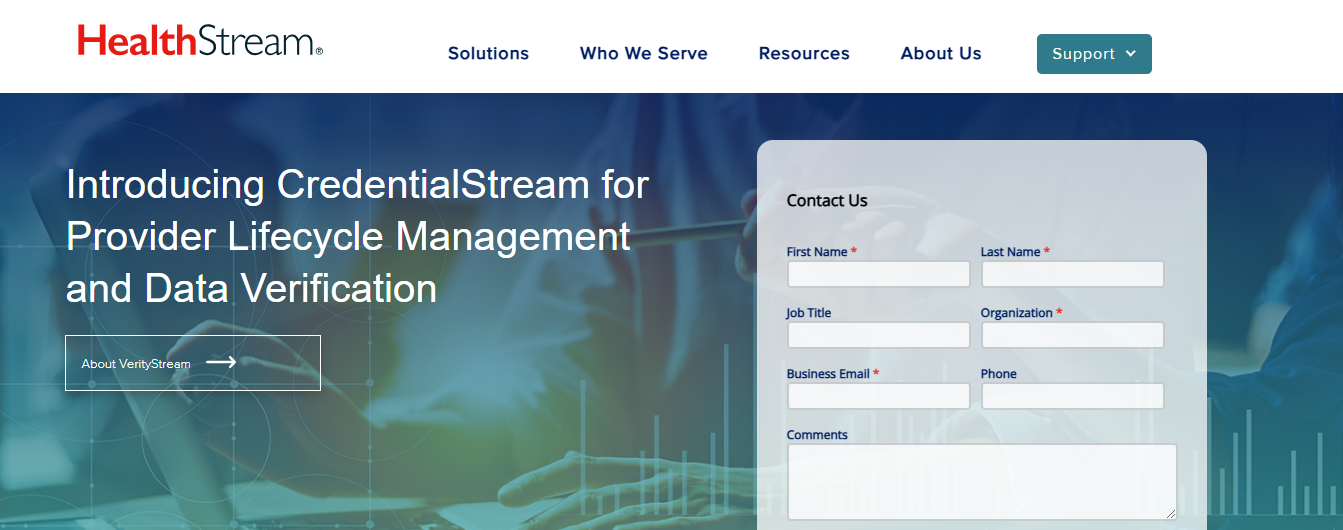

CredentialStream® incorporates patented technology that provides everything necessary for requesting, gathering, and validating information about a provider, all to establish a reliable Source of Truth for downstream processes. With a modern platform that is continuously updated, along with best-practice content libraries and industry-leading data sets, CredentialStream stands out as the most comprehensive provider lifecycle management solution available.
Pros
- Automation: Streamlines credentialing and compliance processes, saving time.
- Accuracy: Reduces human errors with centralized data management.
- Compliance: Ensures adherence to industry regulations.
- Efficiency: Speeds up onboarding and renewals.
- Integration: Works with HR and LMS systems for smooth workflows.
Cons
- Cost: High implementation and licensing fees.
- Setup: Complex and time-consuming to configure.
- Learning Curve: Requires staff training.
6. NextGen Healthcare EHR: Smart Software for Ambulatory Practices
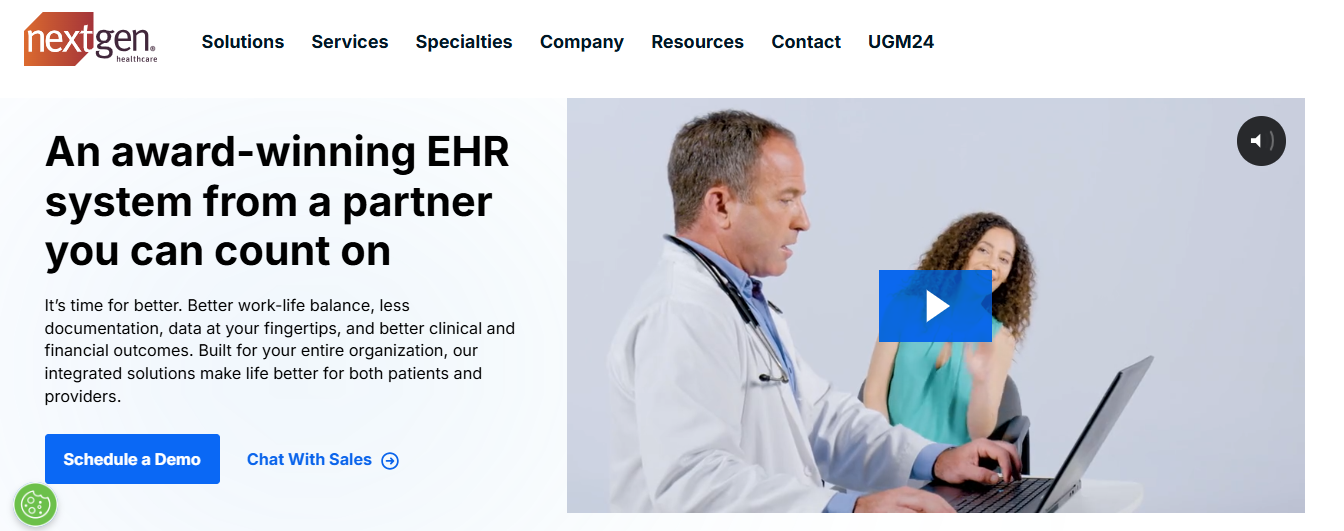

NextGen Healthcare is a leader in healthcare software and services that enables the transformation of ambulatory healthcare. NextGen Office (1-10 doctors) and NextGen Enterprise (10+ doctors) are intelligent electronic health record solutions that help ambulatory practices reduce the burden of documentation, improve clinical outcomes, connect to other health systems, increase provider and patient satisfaction, streamline revenue cycles, and foster healthier communities.
Pros
- User-friendly: The interface is designed for beginners.
- Comprehensive NextGen offers a variety of features for managing patient care.
- Affordable Smaller practices may find NextGen more affordable than other EHR systems.
- Secure NextGen offers secure data sharing and storage.
- Patient portal: The patient portal can help engage patients and improve outcomes.
- SOAP notes: Users can save SOAP notes without losing their format.
Cons
- Cost The price of NextGen may be a deterrent for smaller practices.
- Complexity Some users find NextGen to be complex.
- Setup: Some users need help to set up and transfer data.
- Some users need to do a lot of manual work to get NextGen fully running.
7. KLAS: Improving Healthcare by Helping Organizations Streamline Credentialing
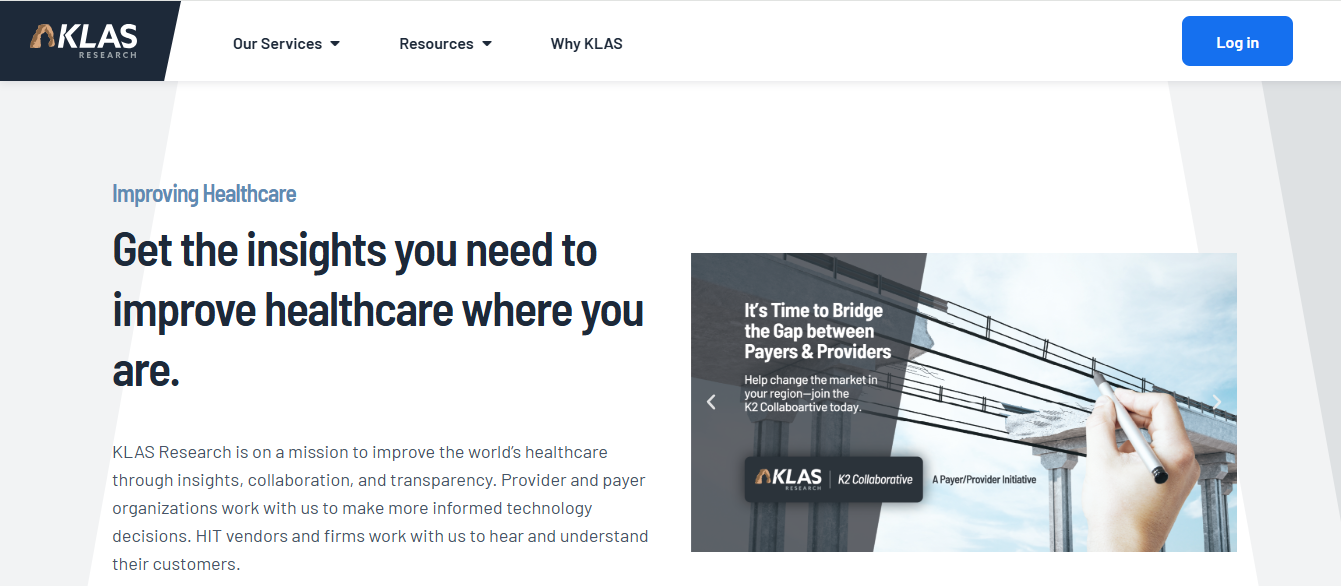

KLAS is a research organization that gathers data on healthcare software and services to provide trustworthy insights for healthcare organizations. Their reports on specific solutions and vendors are based on real-user feedback and can help organizations make informed decisions about the best fit for their needs.
Provider Credentialing Mistakes to Avoid


1. A Short Staff Makes Credentialing Difficult
Provider credentialing is a complex process that requires attention to detail, organization, and communication. Smaller organizations may need help finding the staff to complete the task, leading to costly mistakes. Health systems with hundreds or thousands of affiliated providers must verify the qualifications of every individual, as even a tiny lapse in credentialing can lead to severe legal and financial repercussions. Relying on a limited staff to complete the process can cause delays that affect revenue and lead to stressed workers who are likely to make errors.
2. Incomplete Applications Can Doom the Process
Provider enrollment applications require a lot of information. The average physician enrollment application can exceed 100 pages, and failing to complete the entire application accurately or accepting an incomplete one can cause reimbursement delays.
3. Letting a Provider Treat Patients Before Credentialing is Complete
Allowing a physician to treat patients before the credentialing process is complete can lead to serious legal repercussions. Courts have held hospitals liable when a physician falsifies credentials and the hospital fails to do its due diligence in verifying them. In one of the earliest negligent credentialing cases, a Wisconsin hospital was eager to book surgical cases and failed to verify a surgeon’s credentials properly. Unfortunately, the surgeon provided false information on the application, and the hospital’s failure to detect it led to patient harm when hip surgery went awry.
4. Not Updating and Verifying Information
According to federal and state laws, healthcare practitioners need to renew their licenses and credentials regularly. Initial credentialing and re-credentialing help ensure that healthcare providers are current with their board certifications and licenses. When a hospital fails to stay on top of re-credentialing, it can lead to healthcare providers and facilities performing services that are not certified or licensed. This creates the potential for adverse patient outcomes, leading to expensive malpractice lawsuits.
5. Covering up Prior Adverse Action
Failing to disclose an adverse action is a severe oversight by any provider. However, it is also the responsibility of a healthcare organization to conduct screenings for prior disciplinary actions with a thorough background check. Hospitals and healthcare organizations must verify credentials against databases such as exclusion, sanction, and debarment lists. Using a trusted source that pulls data from primary sources is essential.
6. Failing to Report Adverse Actions
Similar to mistake number 5, providers are required to report adverse actions, such as:
- License revocation
- Exclusion from third-party programs
- Suspension or voluntary relinquishment of medical staff membership, clinical privileges, or state or federal licenses.
- Hospitals and health systems are accountable for a provider’s omission.
- Therefore, due diligence requires background checks to identify current and historical adverse actions.
7. Failing to Report Adverse Actions to the National Practitioner Data Bank (NPDB)
Providers and organizations that fail to report negative actions to the NPDB withhold critical information other organizations need to complete medical credentialing. The NPDB requires reporting of the following actions:
- Medical malpractice payments
- Federal and state licensure and certification actions
- Adverse clinical privileges actions
- Adverse professional society membership actions
- Negative actions or findings by private accreditation and peer review organizations
- Healthcare-related criminal convictions and civil judgments
- Exclusions from participation in a federal or state healthcare program, including Medicare and Medicaid exclusions
- Other adjudicated actions or decisions.
8. Failing to Take Peer Review Activity Seriously
Information provided in a peer review or investigation should be taken seriously and evaluated as part of the credentialing process. Peer references can shed light on the capabilities and competencies of a provider that you cannot glean from simply checking education, training, or license status.
Azulity: The Ultimate Solution for Provider Credentialing
Azulity specializes in healthcare master data management and provider credentialing services, bringing proven expertise in implementing healthcare data solutions and credentialing across the US. Our comprehensive platform ensures consistent patient, provider, location, and claims data synchronization across all systems and departments.
Key features include healthcare MDM, provider MDM, reference data management, credentialing, and provider enrollment. We serve healthcare technology leaders – from CIOs and CDOs to VPs of data platforms and credentialing – helping them eliminate the costly problems of fragmented data systems. Book a call to learn more about our healthcare master data management services today!
Related Reading
- Credentialing and Privileging
- How Much Does Credentialing Cost
- Types of Credentialing in Healthcare
- Hospital Credentialing Requirements
- Primary Source Verification Credentialing
- Provider Enrollment and Credentialing
Book a Call to Learn More About Our Provider Credentialing Services
Provider credentialing establishes the qualifications and legitimacy of healthcare professionals. Also called medical staff credentialing, the process involves verifying a provider’s training, education, residency, and certifications. Credentialing aims to ensure that patients receive care from qualified and competent practitioners. The process can be lengthy and complex, involving numerous stakeholders inside and outside healthcare organizations.
Why Is Provider Credentialing Important?
Credentialing helps healthcare organizations maintain quality by ensuring patients receive care from qualified medical professionals. This process verifies a provider’s qualifications and helps identify any issues that could jeopardize patient safety, such as malpractice claims or a loss of board certifications. When patients receive care from credentialed providers, they can have greater confidence in the quality of that care. Additionally, credentialing helps healthcare organizations comply with regulations and avoid potential legal and financial penalties.
What Is the Provider Credentialing Process?
While the provider credentialing process can vary by organization, the following steps represent a general overview:
Gathering Information
The process begins when a healthcare organization requests basic information about a practitioner. This usually occurs when a provider applies for a position or requests to join a health plan’s network. Organizations can streamline this step by using credentialing software that automates data collection and allows practitioners to enter their information directly into the system.
Verifying the Information
Next, the organization verifies the practitioner’s qualifications by checking references, contacting educational institutions, and reviewing records from state licensing boards and specialty certification organizations.
Making a Decision
After verifying the information, the organization decides on the practitioner’s application. In some cases, a practitioner may be denied privileges based on the findings from the credentialing process. In others, the organization may determine that the provider risks patient safety and requires additional monitoring or oversight.
Ongoing Monitoring
Credentialing is not a one-time event. Once a practitioner is granted privileges, healthcare organizations must continuously monitor their credentials throughout their tenure. This process helps ensure that any changes to a provider’s background, such as disciplinary actions or loss of board certification, are identified and addressed as necessary.
Who Is Involved in the Provider Credentialing Process?
While healthcare organizations oversee provider credentialing, numerous stakeholders are involved. These include:
Practitioners
Providers undergoing credentialing must supply accurate information about their qualifications.
Credentialing Committees
Many organizations have dedicated committees that manage the credentialing process. These committees typically include healthcare leaders and subject matter experts who assess a practitioner’s qualifications and make recommendations regarding their application.
Human Resources
HR departments often help facilitate the credentialing process, especially in larger organizations.
Medical Staff
Existing medical staff often provide input on credentialing, particularly if an applicant is seeking privileges to join their department.
Third-Party Organizations
Some organizations, particularly smaller practices, may outsource credentialing to third-party firms. Additionally, healthcare systems can utilize information from third-party organizations, such as the National Practitioner Data Bank, to verify a provider’s credentials.
How to Streamline the Provider Credentialing Process
Credentialing can be time-consuming and resource-intensive. However, several strategies can help organizations streamline the process. These include:
Use Technology
Healthcare organizations can leverage credentialing software to automate and accelerate many of the steps involved in the credentialing process.
Create a Comprehensive Plan
Establishing policies and procedures can help organizations manage the credentialing process more efficiently.
Stay Compliant
Many of the delays in the credentialing process occur when organizations encounter compliance issues. Staying current on the latest regulations can help organizations avoid these pitfalls and streamline the process.
Monitor Provider Data Continuously
Implementing an effective data management strategy can help organizations minimize the time necessary for credentialing. Continuously monitoring provider data can help identify and address any changes to a practitioner’s background before they impact patient safety.
Azulity: The Ultimate Solution for Provider Credentialing
Azulity specializes in healthcare master data management and provider credentialing services, bringing proven expertise in implementing healthcare data solutions and credentialing across the US. Our comprehensive platform ensures consistent patient, provider, location, and claims data synchronization across all systems and departments.
Key features include healthcare MDM, provider MDM, reference data management, credentialing, and provider enrollment. We serve healthcare technology leaders – from CIOs and CDOs to VPs of data platforms and credentialing – helping them eliminate the costly problems of fragmented data systems. Book a call to learn more about our healthcare master data management services today!
